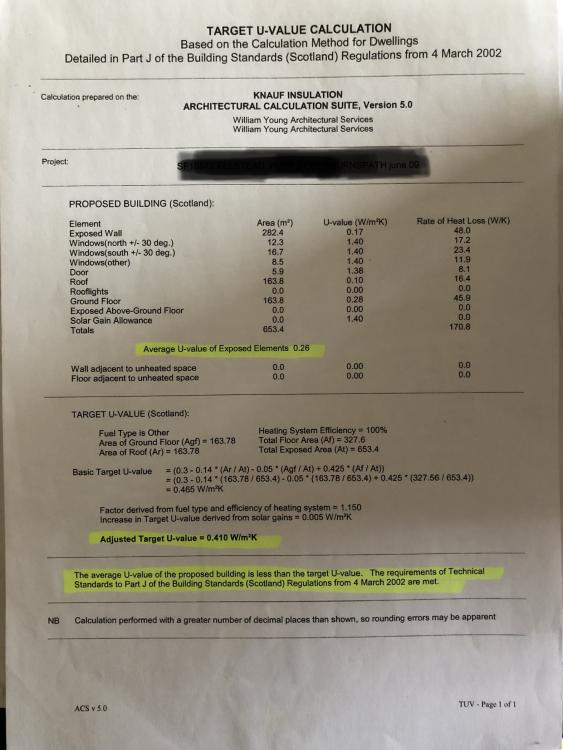Search the Community
Showing results for tags 'u-value'.
-
I know the lower U-value I achieve for my ground floor the better but is there a maximum U-value beyond which under floor heating is not advisable?
-
I have my SAP calculation for my forthcoming bungalow and all generally looks good. The roof and floor have U-values of 0.08 W/m².k. However, the walls are a bit low, about 0.18 W/m².k. I did this on-purpose to maximise floor-space but it has turned-out a bit lower than I expected so I am thinking of adding an additional layer of insulation inside the the airtightness layer of say 25mm or 50mm of PIR. I was planning a 25mm service void anyhow. My questions: Could I just fill that service void with sheet PIR everywhere except where services run? That would do the job without stealing more floor area. I am aware that electrical cables may need de-rating if they are insulated. To counter this, could I just leave, say, 50mm air-gap each side of a cable run? Are there any other problems with largely doing-away with a service void by filling it with insulation? (For service runs, as a bungalow with a warm roof I will have 200mm of open space between the metal-web joists in the flat roof). (The external walls will be 240mm I-beams at 600m centres full-filled with blown-cellulose/Warmcel.) (The airtightness layer is Pro-Passiv Smartply.) (I am aware of condensation-risk analysis and I am confident that adding such a small amount of extra insulation won't cause a problem).
- 8 replies
-
- u-value
- insulation
-
(and 1 more)
Tagged with:
-
u-values How to Calculate U-Values for Ground and First floors?
Chendy posted a topic in Heat Insulation
Hello, I am completely new to the building control process, stumbling my way through, any help very appreciated... I have a maisonette flat situated on the ground and first floors of a 4 storey residential block. The block is a reinforced concrete frame construction. All floors are reinforced concrete slab, with uninsulated screed over the slab. I want to remove the existing screed. Replacing with floor insulation, then a finished concrete floor containing underflooring pipes. I understand from LB1 the new floor should ideally meet a U-value of 0.25 W/m²K, "feasibility" aside. Q1.A How to calculate the U-value of the ground floor? Is this a correct approach? https://warmafloor.co.uk/support-centre/u-values/ is a guide to calculation of the U-Value of the uninsulated floor. based on The IP 3/90 formula is U = 0.05 + 1.65(P/A) – 0.6(P/A)² Where: U = U-Value of the uninsulated floor (W/m²K). P = Length of the exposed perimeter (m). A = Area of the floor (m²) https://insulation-uk.com/member/u-value-calc is an example of a insulation manufacturer provided calculator I have cross compared and they line-up close enough. Q2.A How to calculate the U-value of the first floors within the same dwelling? I haven't been able to find any guides how to do this Whilst it seems a U-value of 0.25 W/m²K still applies, I would assume that first floors within the same property would require less insulation?? the heat only really escapes from thermal bridging of the floor with the wall, heat wasted downstairs is in the same property?? and/or the room below can be assumed to also be heated or normal room temperature, so there won't be such a large temperature difference, so less insulation is needed?? http://files.nu-heat.co.uk/core/media/media.nl?id=237176&c=472052&h=f809f347f001eb168007&_xt=.pdf this datasheet from a underfloor heating company states "In ground floors the insulation beneath the screed should be 70mm ‘Celotex’ or equivalent, or conform to Part L of the Building Regulations; whichever is greater. In upper floors insulation should be to a minimum of 30mm ‘Celotex’ or equivalent to prevent downward heat transmission" Q2.B can anybody link to a formula or calculator to use? Q2.C or is the calculation just the combined U values of the concrete slab + floor insulation? any help very appreciated : )- 3 replies
-
- building regulations
- underfloor heating
-
(and 1 more)
Tagged with:
-
Hello, I'm going building a house in the South West of Ireland with the fabric first approach. I have purchased PHPP and trying to DIY it. Is it Ok to have more Insulation in Floor and Roof than the walls? Floor = 0.108 Walls = 0.15 Roof = 0.117 Or should the U-value's be more even?
-
Hi I think I understand how U-Values are calculated e.g. (Layer thickness) X Lambda = R in m2 K/W Add up all the R-values for each of the layers and 1/(Total R-Value) = U-Value in W/m2 K However if you look at the calculations from my "As-designed" SAP 2009 report below, the calculated Total R-Value = 5.844 m2 K/W and if you take the inverse of that the U-Value is 1/5.844 = 0.171 W/m2 K and not the 0.14 shown on the report below. Can anyone please explain how the 0.14 was achieved...what am I missing??? Thanks
- 13 replies
-
- u-value
- calculation
-
(and 3 more)
Tagged with:
-
Does anyone have a link to an idiot proof guide to help me understand my U-Value calculations, and what ‘Ok’ might look like please. I don’t have a passive house, so it won’t be super efficient, and some of the assumptions in mine aren’t quite right I believe as surely if I have MHRV it shouldn’t say ‘ventilation natural, fans 5’ ? It also doesn’t take the extension into account either. I really just would like to form view of how my house performs, and how I might be able to calculate a revised value. I doubt I can change anything at this stage. Many thanks! Summary of mine is below.
- 17 replies
-
- 1
-

-
Just about to order some more PIR having sorted out my plan of attack. Half of this pitched roof is going to be 'vaulted' (i.e. Just one pitch of the roof with internal wall coming up right up to the ridge). So planning to fill between the 75mm (yes 75mm!) rafters with 25mm PIR and then a further 200mm PIR under the rafters. That leaves me with a 50mm ventilation gap. It's a slated roof with battens (not countered or any sarking) but have Tyvek breather membrane which I think means I could even reduce ventilation gap to 25mm? Build Reg Table 2 seems to say that roof u-value should be 0.18: https://www.gov.uk/government/uploads/system/uploads/attachment_data/file/540327/BR__PDF__AD_L1B_2013_with_2016_amendments.pdf This is a retrofit rather than new build but I want to get as good as I can get u-values and not simply satisfy BR! I've read so many conflicting roof values ranging from 0.11 to 0.2! Just need a sanity check that I'm on the right track here. Celotex calculator tells me I will end up with around 0.1 so with my EWI and 3G windows I am hoping i am on the right path. Everyone's specs are different but with BR values being pretty dire it's difficult to guage what a decent u-value would be! Should I try and improve on 0.1? I may be able to add a further 50mm but would mean fitting the plasterboard becomes a bit more cumbersome (Would probably have to fit battens underneath PIR and then fix PB to that).
-
Depending on the number crunching, I seem to be settling on a 155mm full fill cavity with eps beads for a number of reasons, fast install, builder free installation etc to name a few. With Thermabead's Carbon Saver for example brick outer, 155mm full fill, med dense block inner and plaster finish gives back a u-value of .18. To cost out Thermabead have said to work on the basis of £10pm/sq for a 155mm fill. I was just wondering if anybody had there insulation costs to hand to easily try and draw some comparisons to other methods (I realise this may difficult so cost per meter squ would be easiest) If anybody can suggest other eps bead providers also. Finally, would like to hear people's options on the figures achieved above. I like it as it appears a respectable value for a modest cavity size. Climabead doesn't seem to perform as well (185mm needed to achieve the same), waiting to hear back from Poly-pearl and energystore (all taken from the national bead blowers association website) thanks in advance
- 21 replies
-
Right, evening all. I have sufficient depth in my ground bearing slab build up for 260mm of insulation and need to achieve at least a u-value of 0.11w/m2k. To achieve this I was going to use a mix of PIR and EPS. If I were to use the below, what overall u-value do I end up with? 100mm celotex (0.16) 160mm jablite (0.164) (My P/A is 0.449) Original plan was to go for 275mm EPS which would get me a u-value of 0.11, but now I've got a bit less to play with. I'd like to stick with that target u-value. Head is full of petrol fumes after whackering and levelling all day so my mathematical skills are even worse than usual. Another option I have would be to go for EPS100 instead of EPS70 but I have some 100mm celotex on site that I'de like to use up. Thanks in advance.




